|
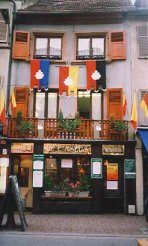 The devotion for St. Ubaldo strongly ties Thann to Gubbio, to the point of the people of Thann saying: "Thann est la fille ainee de Gubbio"
(Thann is the first daughter of Gubbio).
The devotion for St. Ubaldo strongly ties Thann to Gubbio, to the point of the people of Thann saying: "Thann est la fille ainee de Gubbio"
(Thann is the first daughter of Gubbio).
Also for this reason it is for the best that the first "Circle of the Area" of our Association "Eugubini in the world" is formed in Thann:
(Circle St.Thiébaut).
During the centuries the connections between Gubbio and Thann were frequent and never interrupted. Already in the early 1289 Benvenuto, Bishop of Gubbio (1278 - 1294) had been to Alsace, as delegate of the Pope.
In the middle of the 1400 the prior of Thann, Nicolas De Wolfach, probably, came to Gubbio to copy the Life of St. Ubaldo written by Teobaldo and the Lithurgy for the Festa of St. Ubaldo; in fact both the texts are included in the Code of Thann.
In 1544 the priests Ulrich and Thiebaut Hess came to Gubbio where the tradition of the finger of St. Ubaldo at Thann was credible enough to the point that in the consignment document of the Church of St. Ubaldo to the "Regular Lateranese Priests" (1512) it was specified that the body of the Saint had a part of the thumb missing.
In 1705 a delegation lead by Louis de Rouffach and in 1730 the priests Sigismond Gobel and Colin de Valoreilles were again in Gubbio, with the aim of verifying the tradition of Thann, which in the meantime had been put in serious doubt by the recognition of the body of St. Ubaldo in 1593, in which it is stated:
"Corpus inventum intactum cum omnibus suis partibus nullo carens digito nec alio membro..." (the body was found intact with all its parts, with no finger or other member missing...).
Nevertheless, apart from these facts, the people of Thann never stopped believing in the legend, and in its truth, and in 1761 there was a great feast to celebrate the sixth centenary of the foundation of the City. Then the French Revolution, the napoleonic period, the restauration and the wars of the italian revival made the century pass without any contacts, but in 1860, for the preparation of the seventh centenary of the city, the people of Thann came forward again: the dean of Thann, Jean Grienemberger, asked the Bishop of Gubbio, Innocenzo Sannibale (1855-1891), for a small relic of St. Ubaldo, to have something certain. In this occasion small parts of the scalp and parts of the gloves which for centuries covered the holy hands, were sent to Thann. But no assurance of the authenticity of the relic was possible, and the bishop even had to repeat that which was in the recognition of 1593, that is that the body of St. Ubaldo was intact.
 |


 The
The  with its so-called "Eye of the witch" and on the other side by the "Staufen"
with its so-called "Eye of the witch" and on the other side by the "Staufen"
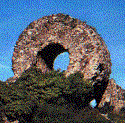 with the monument of the Alsatian Resistence.
with the monument of the Alsatian Resistence.
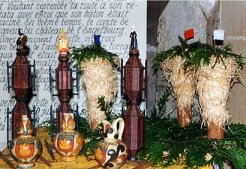 But these two cities were already united many centuries before. We can say that this is the "oldest twin tie in Europe", seing that it was created in 1161, and has its reason for existing and its force in the adoration of the common patron:
But these two cities were already united many centuries before. We can say that this is the "oldest twin tie in Europe", seing that it was created in 1161, and has its reason for existing and its force in the adoration of the common patron:
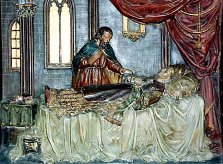 A legend says that when St.Ubaldo was alive he commanded his servant, originally from northern Europe, to take and keep his Bishop ring for himself at the moment of the saint's death (16th May 1160).
The servant did as he was told to do, but when he pulled away the ring, the whole thumb came off. The servant was so shocked, and nevertheless hid that relic as a treasure in his stick knob, and started his journey on foot towards his home town.
A legend says that when St.Ubaldo was alive he commanded his servant, originally from northern Europe, to take and keep his Bishop ring for himself at the moment of the saint's death (16th May 1160).
The servant did as he was told to do, but when he pulled away the ring, the whole thumb came off. The servant was so shocked, and nevertheless hid that relic as a treasure in his stick knob, and started his journey on foot towards his home town.
 In the years 1975-76 the specialists of the Vatican Museum made investigations on the body of St. Ubaldo and arrived at the conclusion that the print of the right hand revealed that the small finger had a missing joint, and resulted to be of the same size as the relic of Thann.
In the years 1975-76 the specialists of the Vatican Museum made investigations on the body of St. Ubaldo and arrived at the conclusion that the print of the right hand revealed that the small finger had a missing joint, and resulted to be of the same size as the relic of Thann.
 The devotion for St. Ubaldo strongly ties Thann to Gubbio, to the point of the people of Thann saying: "Thann est la fille ainee de Gubbio"
(Thann is the first daughter of Gubbio).
The devotion for St. Ubaldo strongly ties Thann to Gubbio, to the point of the people of Thann saying: "Thann est la fille ainee de Gubbio"
(Thann is the first daughter of Gubbio).
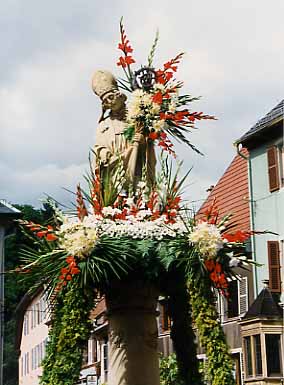 In Thann all they could do was to proceed with the exam of their relic, and it was found that ".... it is not the whole part of the thumb with its bone, but seems to be frumbled skin..."
In Thann all they could do was to proceed with the exam of their relic, and it was found that ".... it is not the whole part of the thumb with its bone, but seems to be frumbled skin..."
 When the clothes were removed, the body was found absolutely intact. On the specific request of Don Ubaldo Braccini, bishop chancellor and historian, very scrupolous about this whole story, the right thumb was carefully valued. It appeared integral, and the missing substance which Dr. Antonioli noted in 1946 was only an opening caused by the dehydration of the body.
When the clothes were removed, the body was found absolutely intact. On the specific request of Don Ubaldo Braccini, bishop chancellor and historian, very scrupolous about this whole story, the right thumb was carefully valued. It appeared integral, and the missing substance which Dr. Antonioli noted in 1946 was only an opening caused by the dehydration of the body.
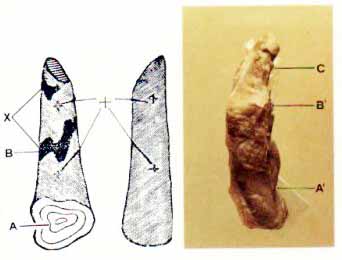 Ubaldo, but is not a part of the thumb, as we thought, but a part of the little right finger which had been torn off the body, and not cut off.
Ubaldo, but is not a part of the thumb, as we thought, but a part of the little right finger which had been torn off the body, and not cut off.
 The great flow of pilgrims stimulated the construction of the present "Collegiale de St. Thièbaut" which lasted more than two centuries and was completed thanks to the generosity of the citizens, the pilgrims and the Asburgs under whose command Thann was from 1324 to 1648.
The great flow of pilgrims stimulated the construction of the present "Collegiale de St. Thièbaut" which lasted more than two centuries and was completed thanks to the generosity of the citizens, the pilgrims and the Asburgs under whose command Thann was from 1324 to 1648.
 is that on the right, a memory of the old church. The left nave is completely in gothic flame style, and presents a portal on the right of which there is a statue of St. Ubaldo with two pilgrims at his feet.
The central nave has four big spans.
is that on the right, a memory of the old church. The left nave is completely in gothic flame style, and presents a portal on the right of which there is a statue of St. Ubaldo with two pilgrims at his feet.
The central nave has four big spans.
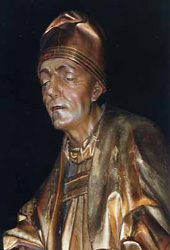 Strasburg is the highest, that of Friburg is the most massive, but that of Thann is the most beautiful!".
Strasburg is the highest, that of Friburg is the most massive, but that of Thann is the most beautiful!".
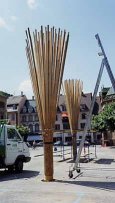
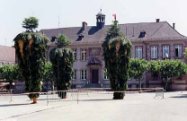 The "Cremations des Trois Sapins" (the lighting of the three fir trees) takes place every 30th of June, the day on which St. Ubaldo's servant arrived in Thann with the relic.
The "Cremations des Trois Sapins" (the lighting of the three fir trees) takes place every 30th of June, the day on which St. Ubaldo's servant arrived in Thann with the relic.
